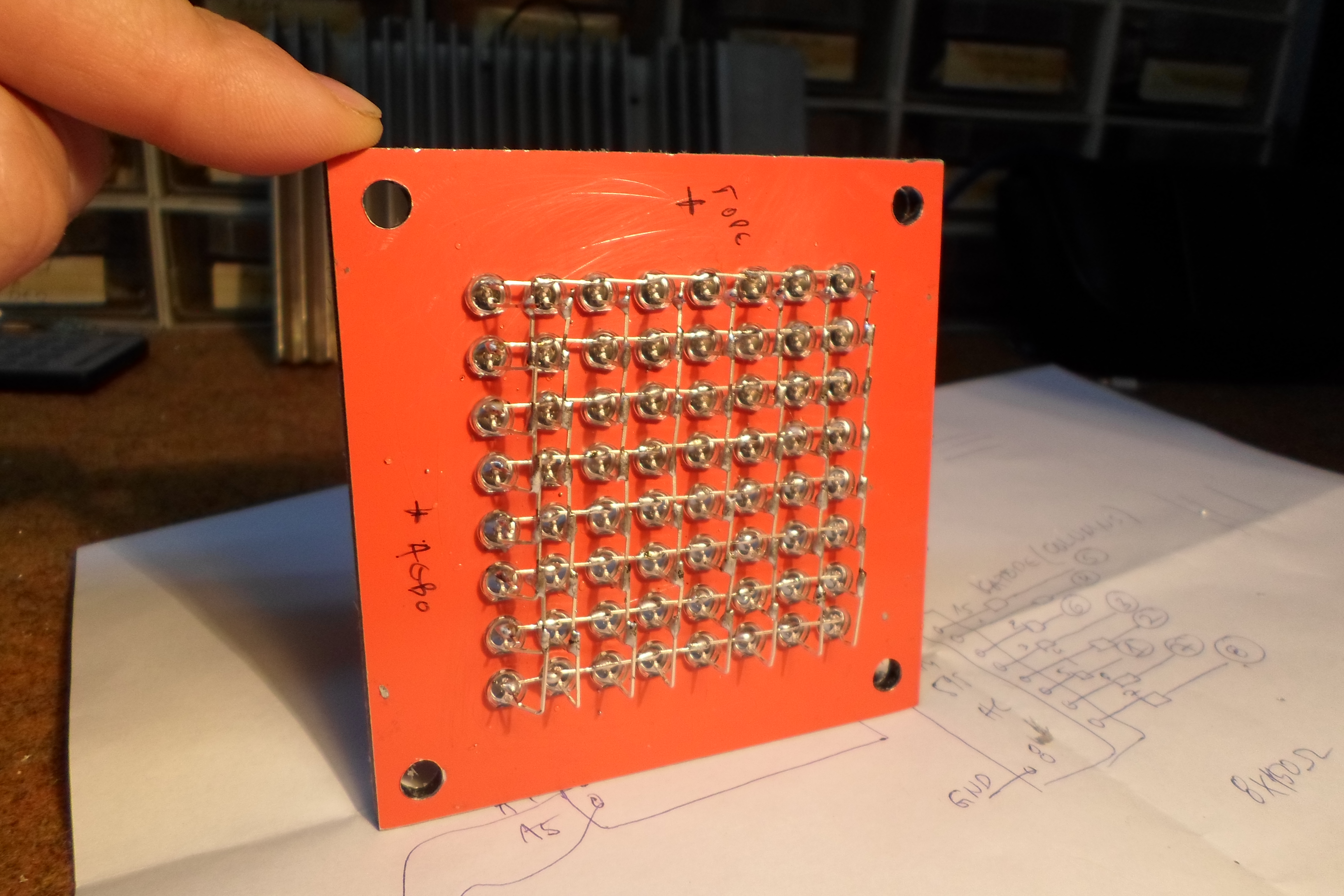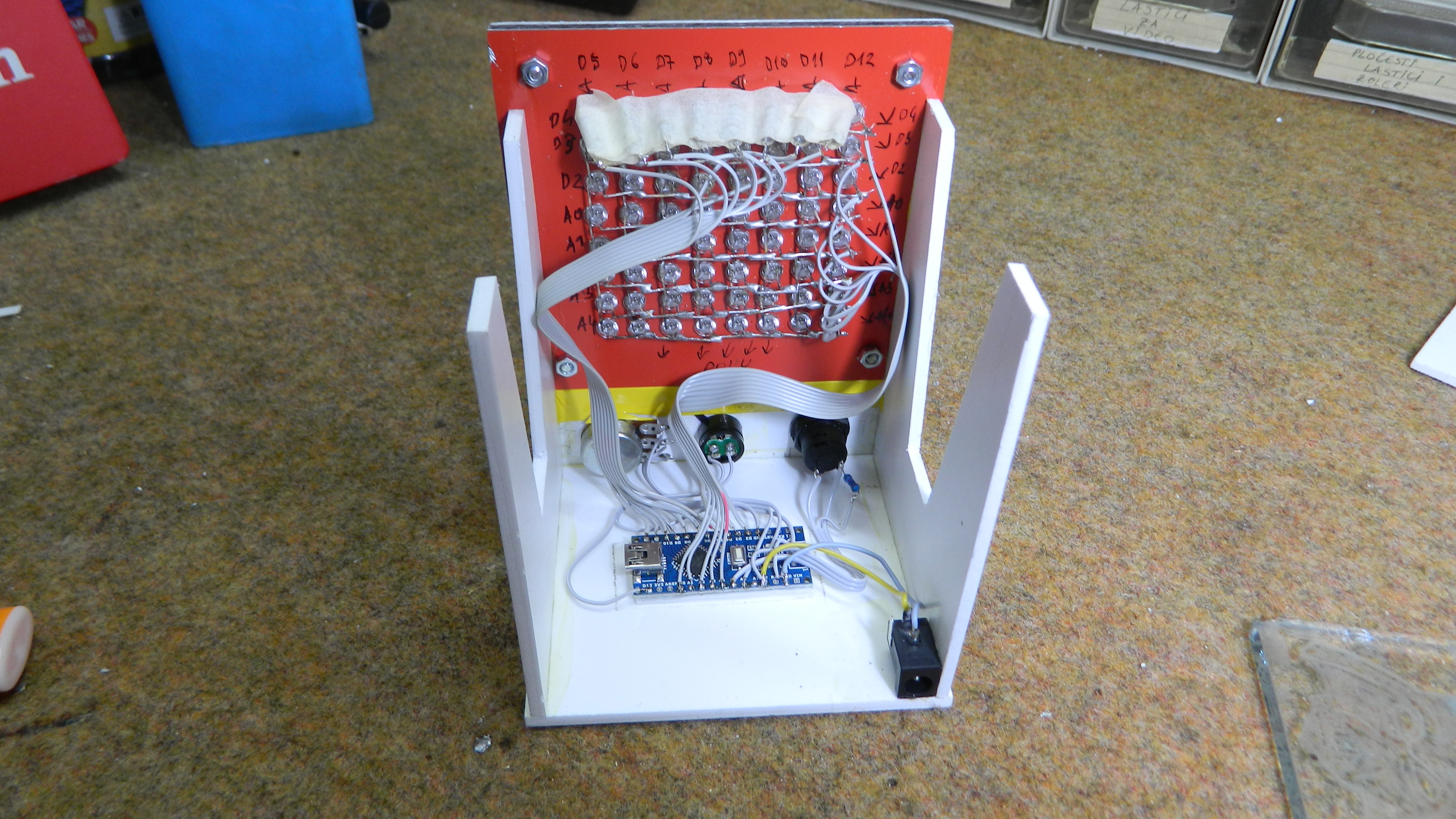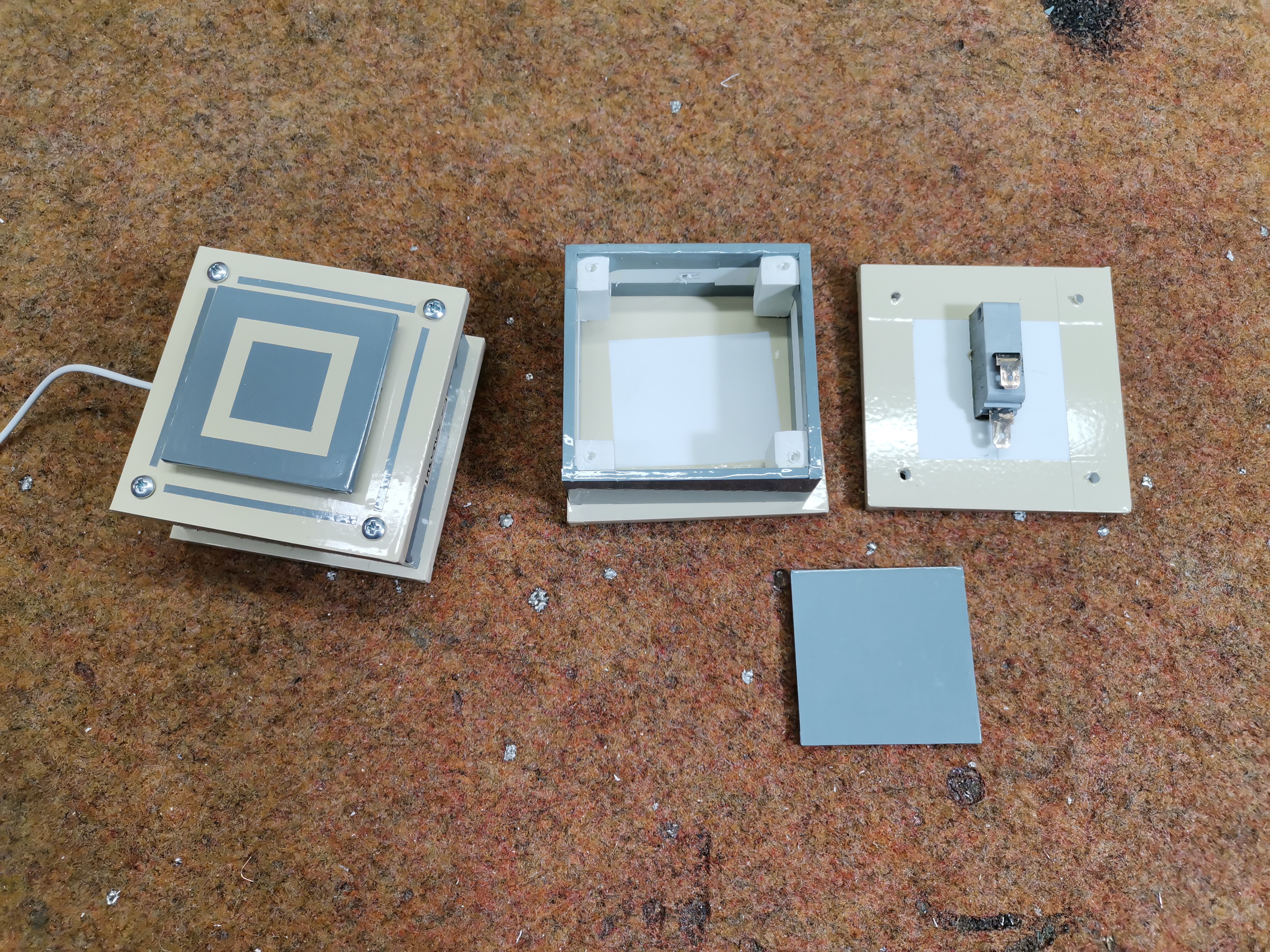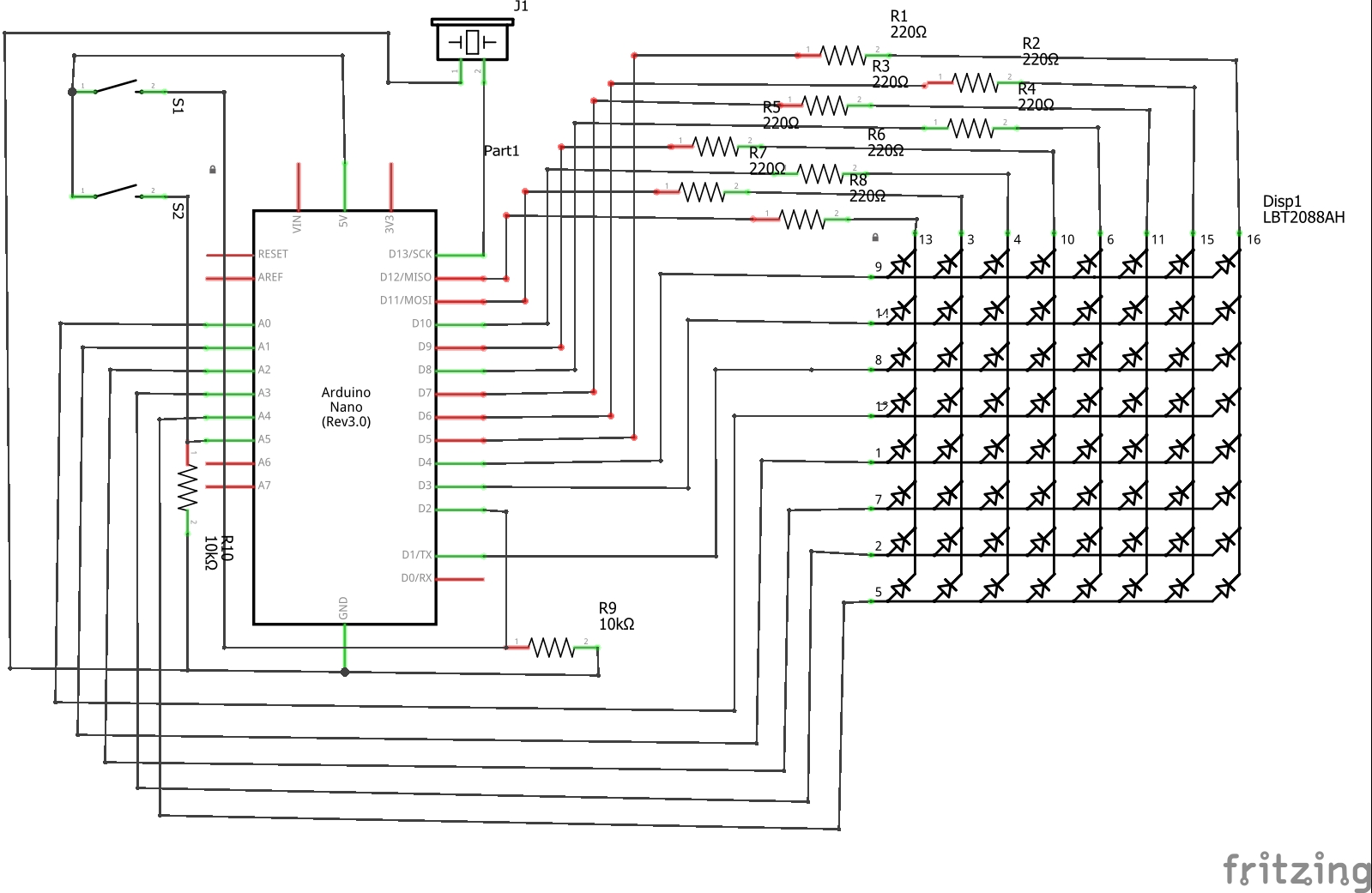//
// Project 1 - Tug-Of-War
//
// Code by Andrew R McHugh
// Gadgets, Carnegie Mellon Univeristy, Hudson
/*
Game Mechanics
--------------
Two players mash their buttons as fast as possible
This creates a tug-of-war with the LED "rope"
When one player gets a point, the board flashes and points to them with an arrow
When one player wins (first to three points), the board flashes and shows the number of the winning player (left = 1, right = 2)
Music plays in the background, randomly generated from the E minor
Music speed increases as either player gets closer to winning a point
*/
// Include libraries
// Letters for the displayed patterns
// Pitches for the music notes
#include "letters.h"
#include "pitches.h"
// Set global variables
// Devmode turns on Serial.print() comments
bool DEVMODE = false;
// Mute mutes the speaker
bool MUTE = false;
// STATE is a variable that controls the global state of the game
enum States {
startup,
play,
playerWin,
win,
postGame,
score
};
States STATE;
// Setup the pins, mostly in arrays
const int ledPinsRows[] = {4, 3, 0, A0, A1, A2, A3, A4};
const int ledPinsCols[] = {12, 11, 10, 9, 8, 7, 6, 5};//0
const int btnPins[] = {A5, 2};
const int musicPin = 13;
// Define the musical scale to randomly pull from
int music[] {
// E Minor
NOTE_E3, NOTE_G3, NOTE_A3, NOTE_B4, NOTE_D4, NOTE_E4, NOTE_G4, NOTE_A4
};
// Number of notes in array
const int noteCount = 8;
// Initializing the position of the current note
int notePosition = 0;
// Durration of notes before speed adjustments, 4 = a quarter note
int noteDurations[] = {
4, 4, 4, 4, 4, 4, 4, 4
};
// Initialize other music variables
int noteDuration; //defined later in the code
int musicSpeed = 1; //1 is normal, 2 is kinda-fast, three is fast
// Defined button labels for ease of use and increased readability
const int LEFT = 0;
const int RIGHT = 1;
// Set the initial states and last states
int btnStates[] = {HIGH, HIGH}; //{left, right}
int btnStatesLast[] = {LOW, LOW};
// Set the initial player scores
int playerScore[] = {1, 1}; // round scores, to be updated per round, based on the math, they start at 1
int playerScoreInit[] = {1, 1}; // defined initial round scores
int playerScoreMaster[] = {0, 0}; // the master score that can change the overall game state
// Initialize the who won last and who the game winner is
int playerWinLast;
int playerWinner;
// Initialize the total score and win location
int totalScore;
int winLocation; // defines the location of the "rope" on the led matrix
// Initialize time variables, definitions follow in code
unsigned long timeStart;
unsigned long timeLimit;
unsigned long timeMeter;
unsigned long masterClock;
unsigned long lastNotePlayedClock;
// Initialize the playArray which gets drawn on the board
int playArray[8][8];
//
// Updates button states. Sets current-stored to
// last then reads current states
//
void updateBtnStates() {
btnStatesLast[LEFT] = btnStates[LEFT];
btnStatesLast[RIGHT] = btnStates[RIGHT];
btnStates[LEFT] = digitalRead(btnPins[LEFT]);
btnStates[RIGHT] = digitalRead(btnPins[RIGHT]);
}
// Draws a given array onto the dot matrix. If
// passed an optional variable "inverse", the
// function draws the inverse of the array.
void draw(const int dotArray[8][8], bool inverse = false) {
// Initialize a this variable
int thisLED = 0;
// Loop that draws the given array onto the matrix
for (int thisRow = 0; thisRow < 8; thisRow++) {
digitalWrite(ledPinsRows[thisRow], LOW);
for (int thisCol = 0; thisCol < 8; thisCol++) {
thisLED = dotArray[thisRow][thisCol];
// checks inverse variable to either make 1s or 0s the drawn dot
if (inverse == false) {
if (thisLED == 1) {
digitalWrite(ledPinsCols[thisCol], HIGH);
}
} else if (inverse == true) {
if (thisLED == 0) {
digitalWrite(ledPinsCols[thisCol], HIGH);
}
}
// Magic sauce
digitalWrite(ledPinsCols[thisCol], LOW);
}
digitalWrite(ledPinsRows[thisRow], HIGH);
}
}
// draw() for a specified amount of time (without interupt)
void drawFor(const int dotArray[8][8], int mil, bool inverse = false) {
// Set time and given duration
timeStart = millis();
timeLimit = timeStart + mil;
timeMeter = timeStart;
// While the counted time is less than the desired limit, keep drawing the array
while (timeMeter < timeLimit) {
// Draw the array
draw(dotArray, inverse);
// Update the counted time
timeMeter = millis();
}
}
// Specific "draw" for setting the matrix on
void setMatrixOn() {
for (int thisCol = 0; thisCol < 8; thisCol++) {
digitalWrite(ledPinsCols[thisCol], HIGH);
}
for (int thisRow = 0; thisRow < 8; thisRow++) {
digitalWrite(ledPinsRows[thisRow], LOW);
}
}
// Specific "draw" for setting the matrix off
void setMatrixOff() {
for (int thisCol = 0; thisCol < 8; thisCol++) {
digitalWrite(ledPinsCols[thisCol], LOW);
}
for (int thisRow = 0; thisRow < 8; thisRow++) {
digitalWrite(ledPinsRows[thisRow], HIGH);
}
}
// A set of development tests, controlled by case switch
// Not used for production
void testMatrix(int test) {
switch (test) {
case 1:
for (int thisCol = 0; thisCol < 8; thisCol++) {
for (int thisRow = 0; thisRow < 8; thisRow++) {
digitalWrite(ledPinsRows[thisRow], LOW);
digitalWrite(ledPinsCols[thisCol], HIGH);
delay(20);
digitalWrite(ledPinsRows[thisRow], HIGH);
digitalWrite(ledPinsCols[thisCol], LOW);
}
}
break;
case 2:
draw(TEST);
break;
default:
setMatrixOn();
delay(100);
setMatrixOff();
}
}
// Turn just one LED on
void ledOn(int row, int col, bool setMatrixOffVar = false) {
// Check to see if we should start by turning the whole matrix off
if (setMatrixOffVar == true) {
setMatrixOff();
}
digitalWrite(ledPinsCols[col], HIGH);
digitalWrite(ledPinsRows[row], LOW);
}
// Turn just one LED off
void ledOff(int row, int col, bool setMatrixOnVar = false) {
// Check to see if we should start by turning the whole matrix on
if (setMatrixOnVar == true) {
setMatrixOn();
}
digitalWrite(ledPinsCols[col], LOW);
digitalWrite(ledPinsRows[row], HIGH);
}
// Update the scores and redraw matrix accordingly
void updateScores() {
// See who is pressing their button
// Only adds one point per press, holding doesn't work here
for (int side = 0; side < 2; side++) {
if ((btnStates[side] != btnStatesLast[side]) && (btnStates[side] == HIGH)) {
playerScore[side]++;
if (DEVMODE == true) {
Serial.print("Player Score ");
Serial.print(side);
Serial.print(playerScore[side]);
Serial.println();
delay(10); //edit
}
}
}
// Can update the buttons states now
updateBtnStates();
// Read scores
// Draw scores based on "winningness"
// If score is high enough, change state to win
// The numbers in this if statement are "magic numbers" I played with them and they
// seem to give an enjoyable experience with variability.
if ((playerScore[LEFT] > 15) || (playerScore[RIGHT] > 15)) {
// Because their score gets mapped to a location on the display, winning requires
// a higher percentage, not pure number. I thus decrement the score (which changes
// the mapping behavior and constrain this adjustment to keep some stability.
playerScore[LEFT] = constrain(playerScore[LEFT] - 4, 0, playerScore[LEFT] - 4);
playerScore[RIGHT] = constrain(playerScore[RIGHT] - 4, 0, playerScore[RIGHT] - 4);
}
totalScore = playerScore[LEFT] + playerScore[RIGHT];
// Maps the scores to a usable location. -1 and 9 are the win states
winLocation = map(playerScore[RIGHT], 0, totalScore, -1, 9);
// Update the music speed based on their "winningness" location on the matrix
updateMusicSpeed(winLocation);
// Dev function
if (DEVMODE == true) {
Serial.println(winLocation);
}
// Win state
if (winLocation == -1) {
playerScoreMaster[LEFT] += 1;
playerWinLast = LEFT;
STATE = playerWin;
}
// Win state
else if (winLocation == 9) {
playerScoreMaster[RIGHT] += 1;
playerWinLast = RIGHT;
STATE = playerWin;
}
// If you don't win, draw the matrix again
else {
for (int j = 0; j < 8; j++) {
for (int i = 0; i < 8; i++) {
// Selectively draw two lines for the pure center of the matrix
if ((winLocation == 4) && (j == winLocation)) {
playArray[i][j] = 1;
playArray[i][j - 1] = 1;
}
// Otherwise draw a single line on either side of center
else if ((winLocation < 4) && (j == winLocation)) {
playArray[i][j] = 1;
}
else if ((winLocation > 4) && (j == winLocation - 1)) {
playArray[i][j] = 1;
}
else {
playArray[i][j] = 0;
}
}
}
// Now that you've prepared the array, draw it
draw(playArray);
}
}
// When a player wins a round...
void playerWinSingle() {
// Flashes the board and points to who won the round
drawFor(OFF, 300);
drawFor(ON, 300);
drawFor(OFF, 300);
drawFor(ON, 300);
if (playerWinLast == LEFT) {
drawFor(ARROW_LEFT, 1000);
}
else if (playerWinLast == RIGHT) {
drawFor(ARROW_RIGHT, 1000);
}
// Dev function
if(DEVMODE == true){
Serial.print("Player win last ");
Serial.println(playerWinLast);
Serial.print("Player winner ");
Serial.println(playerWinner);
Serial.print("Player score master left ");
Serial.println(playerScoreMaster[LEFT]);
Serial.print("Player score master right ");
Serial.println(playerScoreMaster[RIGHT]);
}
// If one of the players has reached three points, set the overall game state to win
if ((playerScoreMaster[LEFT] == 3) || (playerScoreMaster[RIGHT] == 3)) {
if (playerScoreMaster[LEFT] == 3) {
playerWinner = LEFT;
}
else if ((playerScoreMaster[RIGHT] == 3)) {
playerWinner = RIGHT;
}
STATE = win;
}
// But if no one wins, set the game state back to play and reset player round scores
else {
STATE = play;
playerScore[LEFT] = playerScoreInit[LEFT];
playerScore[RIGHT] = playerScoreInit[RIGHT];
}
}
// If a player wins the entire game...
void playerWinGame() {
// Flash the board
drawFor(OFF, 300);
drawFor(ON, 300);
drawFor(OFF, 300);
drawFor(ON, 300);
// Draw their number if left
if (playerWinner == LEFT) {
drawFor(PLAYER_1, 1000);
drawFor(PLAYER_1, 500, true);
drawFor(PLAYER_1, 1000);
drawFor(PLAYER_1, 500, true);
drawFor(PLAYER_1, 1000);
drawFor(PLAYER_1, 500, true);
drawFor(PLAYER_1, 1000);
}
// or if right
else if (playerWinner == RIGHT) {
drawFor(PLAYER_2, 1000);
drawFor(PLAYER_2, 500, true);
drawFor(PLAYER_2, 1000);
drawFor(PLAYER_2, 500, true);
drawFor(PLAYER_2, 1000);
drawFor(PLAYER_2, 500, true);
drawFor(PLAYER_2, 1000);
}
}
// Sometimes you have to stop the love
// Shorthand to stop playing the music
void stopMusic() {
noTone(musicPin);
}
// A small function that updates the music speed based on the
// level of "winningness". More win equals more fast.
void updateMusicSpeed(int winLocation) {
int absWinLocation = abs(winLocation - 4);
if (absWinLocation < 2) {
musicSpeed = 1; // normal speed
}
else if (absWinLocation < 3) {
musicSpeed = 2; // kinda-fast
}
else {
musicSpeed = 3; // real-fast
}
}
// Function that plays the music
// Optionally, it can run "asyncronously"
// Syncronous function adapted from Melody example
void playMusic(int toneSpeed, bool async = false) {
// No music if you've muted
if (MUTE == true) {
stopMusic();
}
else {
// If you're doing asyncronous playing
if (async == true) {
/*
Get masterclock time
If masterclock time > lastnoteplayed + noteduration,
play next note
Otherwise keep playing the current note
*/
masterClock = millis();
noteDuration = (1000 / noteDurations[notePosition]) / toneSpeed;
if (masterClock > lastNotePlayedClock + noteDuration) {
if (music[notePosition] == 0) {
noTone(musicPin);
}
else {
tone(musicPin, music[notePosition]);
}
// Choose a random note to play
notePosition = random(0, 7) % noteCount;
lastNotePlayedClock = millis();
}
}
// this is basically exactly what was in the Melody example
else if (async == false) {
// iterate over the notes of the melody:
for (int thisNote = 0; thisNote < noteCount; thisNote++) {
// to calculate the note duration, take one second
// divided by the note type.
//e.g. quarter note = 1000 / 4, eighth note = 1000/8, etc.
noteDuration = (1000 / noteDurations[thisNote]) / toneSpeed;
tone(musicPin, music[thisNote], noteDuration);
// to distinguish the notes, set a minimum time between them.
// the note's duration + 30% seems to work well:
double pauseBetweenNotes = noteDuration * 1;
delay(pauseBetweenNotes);
// stop the tone playing:
noTone(musicPin);
}
}
}
}
// To restart the game, you can hold both buttons down after someone wins
void restart() {
updateBtnStates();
if ((btnStates[LEFT] == HIGH) && (btnStates[LEFT] == HIGH)) {
playerScore[LEFT] = playerScoreInit[LEFT];
playerScore[RIGHT] = playerScoreInit[RIGHT];
playerScoreMaster[LEFT] = 0;
playerScoreMaster[RIGHT] = 0;
STATE = startup;
}
}
// The initial draw function, "loading"
void drawStartup() {
for (int i = 0; i < 8; i++) {
for (int j = 0; j < 8; j++) {
ledOn(i, j, true);
delay(25);
}
}
playMusic(1);
playMusic(2);
playMusic(1);
STATE = play;
}
// The setup function. It sets up the environment on load.
void setup() {
masterClock = millis();
if (DEVMODE == true) {
Serial.begin(9600);
}
// Set LEDs to output
for (int thisLED = 0; thisLED < 8; thisLED++) {
pinMode(ledPinsCols[thisLED], OUTPUT);
};
for (int thisLED = 0; thisLED < 8; thisLED++) {
pinMode(ledPinsRows[thisLED], OUTPUT);
};
pinMode(musicPin, OUTPUT);
// Set btns to input
pinMode(btnPins[LEFT], INPUT);
pinMode(btnPins[RIGHT], INPUT);
if (DEVMODE == true) {
// flash the board to make sure everything is plugged in
setMatrixOn();
delay(300);
setMatrixOff();
Serial.println("Setup complete");
}
// Set game state
STATE = startup;
}
void loop() {
// Master switch that controls what happens in which game state
switch (STATE) {
case startup:
drawStartup();
break;
case play:
updateScores();
playMusic(musicSpeed, true);
break;
case playerWin:
stopMusic();
playerWinSingle();
break;
case win:
stopMusic();
playerWinGame();
restart();
break;
}
}







